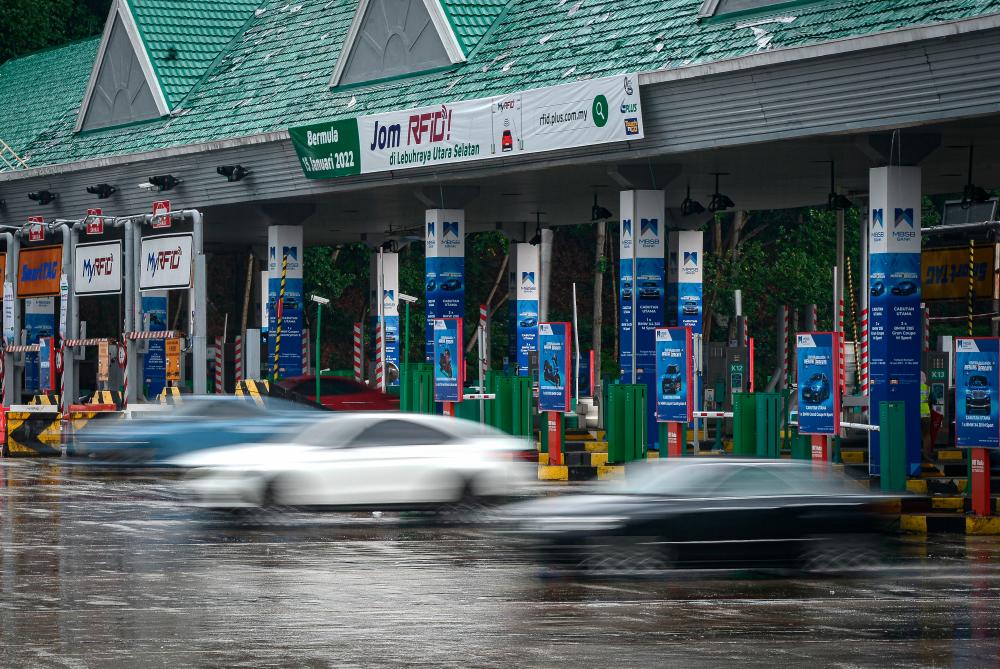KUALA LUMPUR: Are Malaysians averse to innovation and are more comfortable using existing technologies? This was among the questions that arose after many highway users made it clear that they prefer to stick to SmartTAG rather than the radio frequency identification (RFID) system for their toll transactions.
PLUS Malaysia Bhd’s rollout of the RFID system from Juru, Penang, to Skudai, Johor, on the North-South Expressway starting Jan 15 has elicited a less than favourable response from road users who questioned the effectiveness of the new toll collection system.
Considering the massive traffic congestion that built up at various toll plazas on the first day of its implementation, the road users’ concerns were legitimate.
They disputed PLUS’ rationale behind using the RFID digital data technology which, they said, inconvenienced them as many of them found themselves stuck at toll booths as their RFID sticker or tag could not be read by the scanner. This ran contrary to RFID’s goal of easing traffic congestion and speeding up toll transactions.
The challenges that arose following the implementation of RFID have also affected PLUS’ efforts to phase out the use of Touch ‘n Go and SmartTAG and eliminate toll barriers by 2023.
Do away with toll barriers
Apart from the RFID tag detection system that malfunctioned, other issues raised by motorists include the rather steep cost of installing the RFID sticker as well as its poor quality, claiming that the sticker can be easily damaged.
Several engineering experts contacted by Bernama said people are willing to accept any new technology provided that it is truly effective and benefits them.
Universiti Kebangsaan Malaysia Faculty of Engineering and Built Environment senior lecturer Associate Prof Dr Sawal Hamid Md Ali said people have the right to question the rationale behind replacing the existing toll collection system with the new RFID technology if the latter is beset with weaknesses and is not very different from the system it has replaced.
According to him, it is more practical to implement a barrier-free toll collection system. Considering that the barrier toll system is part of RFID, it still requires vehicles to slow down when going through the toll booth.
“And, when the (RFID) system can’t detect the tag or it malfunctions, the barrier will not rise to let the vehicle go through, which happens frequently in the case of SmartTag users (also due to tag detection issues),” he told Bernama.
“If RFID users face the same problems as those using SmartTAG – which has about five million users – then questions are bound to arise why people should change to RFID.”
Pointing to Singapore, Dr Sawal Hamid said the republic was the first country in the world to use a barrier-less toll system after it introduced the Electronic Road Pricing (ERP) system in 1998 which proved effective in reducing traffic congestion.
“The ERP system requires a device that operates on battery power, similar to SmartTAG, as well as a card like Touch ‘n Go, with the card keeping a record of the cash balance in the device,” he explained.
Implement RFID in stages
Dr Sawal Hamid suggested that PLUS implement RFID in stages to enable highway users to familiarise themselves with it gradually while improvements are made to the RFID system.
“The SmartTAG lanes must also be retained. This way, users have a choice of using Touch ‘n Go, SmartTAG or RFID.
“... after the RFID system is improved, then (the authorities) can consider converting all the SmartTAG lanes to RFID,” he added.
He also said that if the authorities continue to use the barrier toll system, then the barrier must be made to lift up for vehicles to pass through even if there is insufficient balance in the e-wallet. The remaining toll payment can be deducted when the user reloads his/her e-wallet.
“This is to avoid inconveniencing road users in the event they don’t have enough money (for their toll payment in their e-wallet) and the barrier doesn’t lift up. These things need to be improved to ensure that the RFID system is beneficial and can overcome congestion issues, as well as smoothen traffic flow,” he added.
Price too high
Meanwhile, Universiti Putra Malaysia Faculty of Human Ecology senior lecturer Dr Irwan Syah Md Yusoff opined that the RFID tag or sticker, which is priced at RM35 each, is not only costly but vulnerable to damage as well.
“Placing the sticker on the vehicle’s front light can lead to it being stolen or vandalised,” he said.
Malaysian Muslim Consumers Association chairman Datuk Nadzim Johan had also recently voiced his dissatisfaction over the price of the RFID sticker, saying that a more reasonable price would be RM1 or RM2.
Malay Economic Action Council chairman Abdul Halim Husin said the authorities, including PLUS, should bear the full cost of providing the RFID sticker to SmartTAG users who wish to switch to the RFID system.
Irwan Syah, who is an expert in ergonomics, said prolonged exposure to extreme heat may affect the effectiveness of the RFID tag.
“In situations like this (when the tag malfunctions), vehicles using the RFID lane are forced to stop suddenly, which can slow down the movement of traffic... it can become worse during peak hours which will impact drivers psychologically,” he said.
Following public complaints about the RFID system, the government decided on Jan 19 that highway users can continue using Touch’ n Go or SmartTAG to pay their toll.
PLUS has also reactivated the SmartTAG lanes that were previously closed at 16 toll plazas. - Bernama














